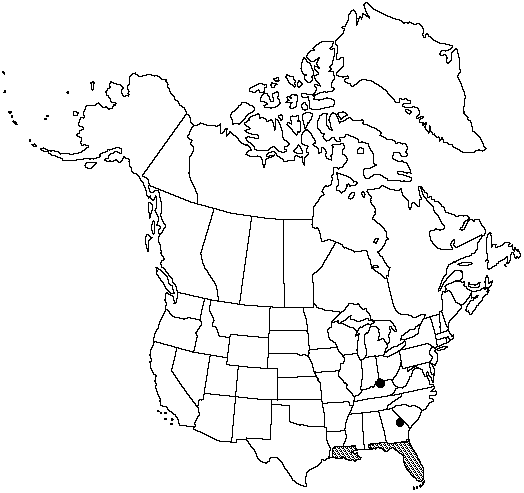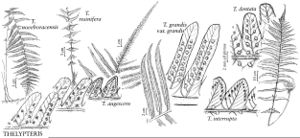Difference between revisions of "Thelypteris dentata"
Amer. Fern J. 26: 44. 1936.
FNA>Volume Importer |
FNA>Volume Importer |
||
| Line 35: | Line 35: | ||
}}<!-- | }}<!-- | ||
| − | --><span class="statement" id="st- | + | --><span class="statement" id="st-undefined" data-properties=""><b>Stems </b>short-creeping, 4–6 mm diam. <b>Leaves</b> often somewhat dimorphic, evergreen, often closely placed, 50–150 cm, fertile leaves with longer petioles and more contracted pinnae. <b>Petiole</b> often purplish brown, 15–50 cm × 3–6 mm, at base with brown, linear-lanceolate, hairy scales. <b>Blade</b> (25–)40–100 cm, 1–4(–6) proximal pairs of pinnae reduced, blade gradually tapered to pinnatifid apex. <b>Pinnae</b> 7–17 × 1–3 cm, incised 1/2–3/4 of width; segments rounded at apex, basal acroscopic segment of proximal pinnae often auriculate; proximal pair of veins from adjacent segments united at obtuse angle below sinus with excurrent vein 2–4 mm. <b>Indument</b> abaxially of uniformly short hairs 0.1–0.2 mm on costae, veins, and blade tissue; veins adaxially with stouter hairs, also with hairs 0.1–0.2 mm on blade tissue. <b>Sori</b> round, medial to supramedial; indusia tan, pubescent, hairs 0.1–0.3 mm; sporangial stalks with orangish, stalked glands. <b>2n</b> = 144.</span><!-- |
-->{{Treatment/Body | -->{{Treatment/Body | ||
| Line 60: | Line 60: | ||
|elevation=0–100 m | |elevation=0–100 m | ||
|distribution=Ala.;Fla.;Ga.;Ky.;La.;s Mexico;West Indies in the Antilles;South America to n Argentina;native to tropical and subtropical Asia;Africa. | |distribution=Ala.;Fla.;Ga.;Ky.;La.;s Mexico;West Indies in the Antilles;South America to n Argentina;native to tropical and subtropical Asia;Africa. | ||
| + | |introduced=true | ||
|reference=None | |reference=None | ||
|publication title=Amer. Fern J. | |publication title=Amer. Fern J. | ||
|publication year=1936 | |publication year=1936 | ||
|special status= | |special status= | ||
| − | |source xml=https://jpend@bitbucket.org/aafc-mbb/fna- | + | |source xml=https://jpend@bitbucket.org/aafc-mbb/fna-data-curation.git/src/9216fc802291cd3df363fd52122300479582ede7/coarse_grained_fna_xml/V2/V2_707.xml |
|genus=Thelypteris | |genus=Thelypteris | ||
|subgenus=Thelypteris subg. Cyclosorus | |subgenus=Thelypteris subg. Cyclosorus | ||
|species=Thelypteris dentata | |species=Thelypteris dentata | ||
| − | |||
| − | |||
| − | |||
| − | |||
| − | |||
| − | |||
| − | |||
| − | |||
| − | |||
| − | |||
| − | |||
| − | |||
| − | |||
| − | |||
| − | |||
| − | |||
| − | |||
| − | |||
| − | |||
| − | |||
| − | |||
| − | |||
| − | |||
| − | |||
| − | |||
| − | |||
| − | |||
| − | |||
| − | |||
| − | |||
| − | |||
| − | |||
| − | |||
| − | |||
| − | |||
| − | |||
| − | |||
| − | |||
| − | |||
| − | |||
| − | |||
| − | |||
}}<!-- | }}<!-- | ||
-->[[Category:Treatment]][[Category:Thelypteris subg. Cyclosorus]] | -->[[Category:Treatment]][[Category:Thelypteris subg. Cyclosorus]] | ||
Revision as of 13:26, 27 July 2019
Stems short-creeping, 4–6 mm diam. Leaves often somewhat dimorphic, evergreen, often closely placed, 50–150 cm, fertile leaves with longer petioles and more contracted pinnae. Petiole often purplish brown, 15–50 cm × 3–6 mm, at base with brown, linear-lanceolate, hairy scales. Blade (25–)40–100 cm, 1–4(–6) proximal pairs of pinnae reduced, blade gradually tapered to pinnatifid apex. Pinnae 7–17 × 1–3 cm, incised 1/2–3/4 of width; segments rounded at apex, basal acroscopic segment of proximal pinnae often auriculate; proximal pair of veins from adjacent segments united at obtuse angle below sinus with excurrent vein 2–4 mm. Indument abaxially of uniformly short hairs 0.1–0.2 mm on costae, veins, and blade tissue; veins adaxially with stouter hairs, also with hairs 0.1–0.2 mm on blade tissue. Sori round, medial to supramedial; indusia tan, pubescent, hairs 0.1–0.3 mm; sporangial stalks with orangish, stalked glands. 2n = 144.
Habitat: Damp woods
Elevation: 0–100 m
Distribution

Ala., Fla., Ga., Ky., La., s Mexico, West Indies in the Antilles, South America to n Argentina, native to tropical and subtropical Asia, Africa.
Discussion
Thelypteris dentata probably does not persist northward in areas (such as Kentucky) where winters are sometimes severe (R. Cranfill 1980).
Selected References
None.
